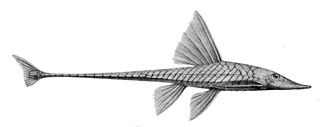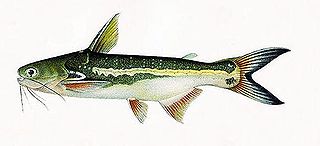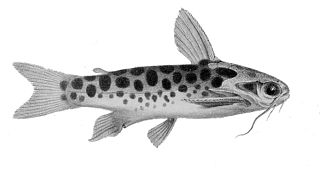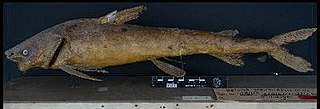
Ancistrus is a genus of nocturnal freshwater fish in the family Loricariidae of order Siluriformes, native to freshwater habitats in South America and Panama. Fish of this genus are common in the aquarium trade where they are known as bushynose or bristlenose catfish. In the aquarium hobby they are often referred to as bushynose or bristlenose plecos instead, but this may lead to confusion as "pleco" usually is used for Hypostomus plecostomus and its allies and is often used as a catchall term for any loricariids remotely resembling that species.

Rineloricaria is a genus of freshwater tropical catfish belonging to the family Loricariidae. They are commonly called whiptail catfish because of the long filament that grows out of the tip of the caudal fin that is characteristic of the genus. With the exception of R. altipinnis from Panama, they are native to the rivers of northern and central South America. Some species are regularly seen in the aquarium trade.

Astroblepus is a genus of fish in the family Astroblepidae found in South America and Panama. This genus is the only member of its family. These catfishes are primarily found in torrential streams in the Andean area. Astroblepus pholeter and A. riberae are troglobites adapted to living in subterranean water systems. These species are typically small, less than 10 cm (4 in). The largest species reaches 30 cm (1 ft). These fish have suckermouths like those of loricariids. They have two pairs of barbels, maxillary and nasal. The dorsal fin spine lacks a locking mechanism. These fish also have odontodes, tiny teeth on their skin. All species exhibit a conical, pointy type on their fin rays like that found in other loricarioids; other species also exhibit a blunt type that is only found on their skin.

Farlowella is a genus of fish in the family Loricariidae native to South America. This genus is broadly distributed in Amazon, Orinoco, Paraná and coastal rivers of the Guyana Shield. It is absent from the Pacific slope of the Andes and from the coastal rivers of the Brazilian Shield. Many of these species are kept in aquariums. This genus has a unique body shape that resembles a thin stick of wood. The body is slender and elongate, often with a pronounced rostrum and a brownish color with two lateral dark stripes beginning at the tip of the rostrum, passing over the eyes and ending at the tail, which are periodically interrupted on the caudal peduncle.

Steindachneridion is a genus of South American pimelodid catfish.

Acanthodoras is a genus of thorny catfishes native to rivers of tropical South America.

Pimelodus is a genus of fish in the family Pimelodidae native to Central and South America.

Sturisoma is a genus of armored catfishes native to Central and South America.

Cathorops is a genus of catfishes in the family Ariidae found in the Atlantic and Pacific Oceans. These species are found in the eastern and western Central and South America in brackish and freshwater habitats. This genus is a strongly supported clade of this family. It consists of a natural group in which the monophyly is well-defined by morphological and molecular evidence and the genus probably includes several unrecognized species from both American coasts.

Pimelodella is a genus of three-barbeled catfishes.

Bunocephalus is a genus of banjo catfishes from South America. It is found in Magdalena, Orinoco, Amazon, Paraguay-Paraná, and São Francisco Rivers. It is also the only aspredinid genus found west of the Andes, found in the Atrato, San Juan, and Patía Rivers. This genus is a part of the family Aspredinidae, known as banjo catfishes for their large, flattened heads and slender tails that give the appearance of a banjo. Most species exhibit cryptic coloration, and the same holds true among Bunocephalus species. The skin is completely keratinized and is covered by large, unculiferous tubercles. Bunocephalus species may reach up to 13 centimetres SL.

Ageneiosus is a genus of driftwood catfishes found mostly in South America with one species extending into Central America.

Cetopsorhamdia is a genus of three-barbeled catfishes native to South America.

Trachelyopterus is a genus of driftwood catfishes. They have been found in South American environments, including Venezuela, Colombia, Peru, Argentina, and several places in Brazil. They have a body pattern that follows bilateral symmetry and reproduce sexually. In terms of sensory systems, Trachelypterus’ have autoliths for hearing and lens eyes for seeing; they also have capabilities of electroreception. The size and appearance of different species within the Trachelyopterus genus varies, with sizes ranging from 5.5 inches in T. albicrux to 7.9 inches in T. insignis to 8.4 inches in T. lucenai. These small catfishes are marketed towards aquariums.

Chaetostoma, also known as the bristlemouth catfish, is a genus of suckermouth armored catfishes native to South America with one species, C. fischeri, extending into Panama. Most species inhabit flowing rivers in the lower Andes and its foothills. Some species are kept in unheated aquaria.

Tatia is a genus of small South American catfishes belonging to Auchenipteridae, the driftwood catfish family.

Notarius is a genus of fish in the family Ariidae found in the Atlantic and Pacific Ocean.
Delturus is a genus of armored catfishes native to rivers in Southeast and Northeast Brazil.
Dolichancistrus is a genus of suckermouth armored catfishes native to South America.

















